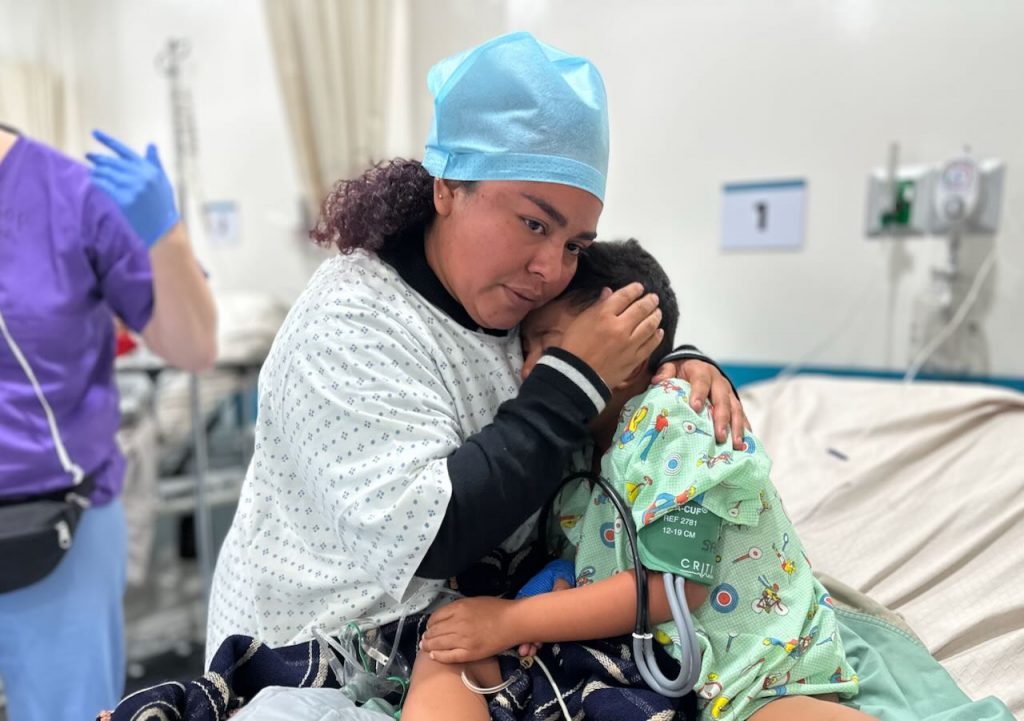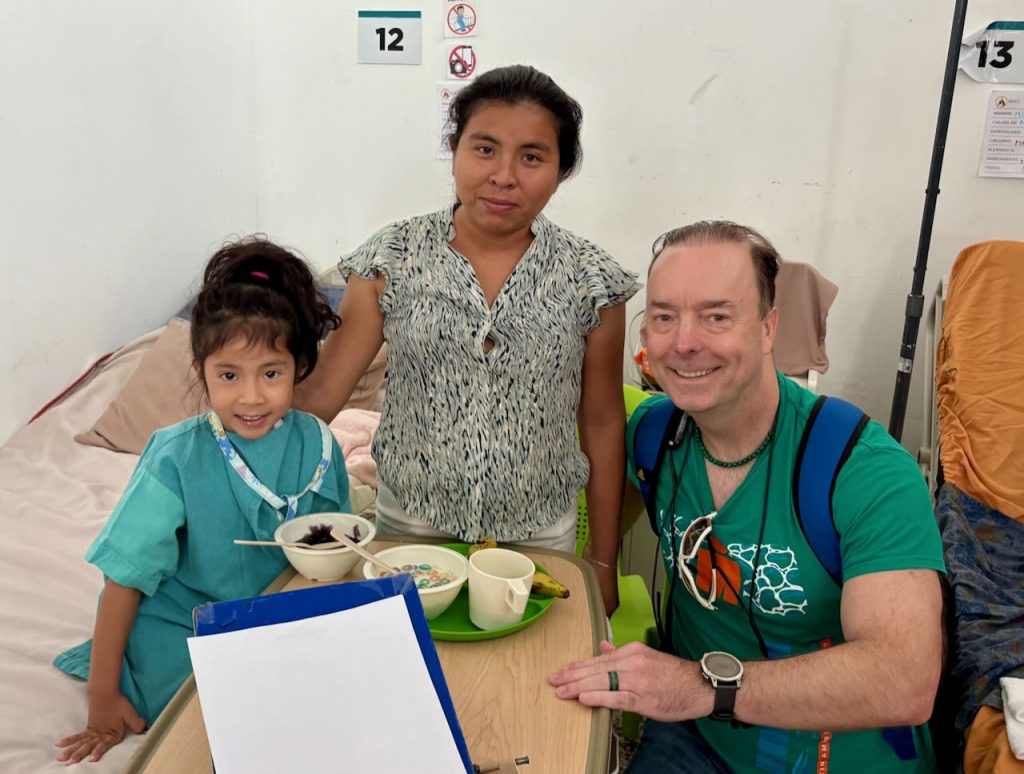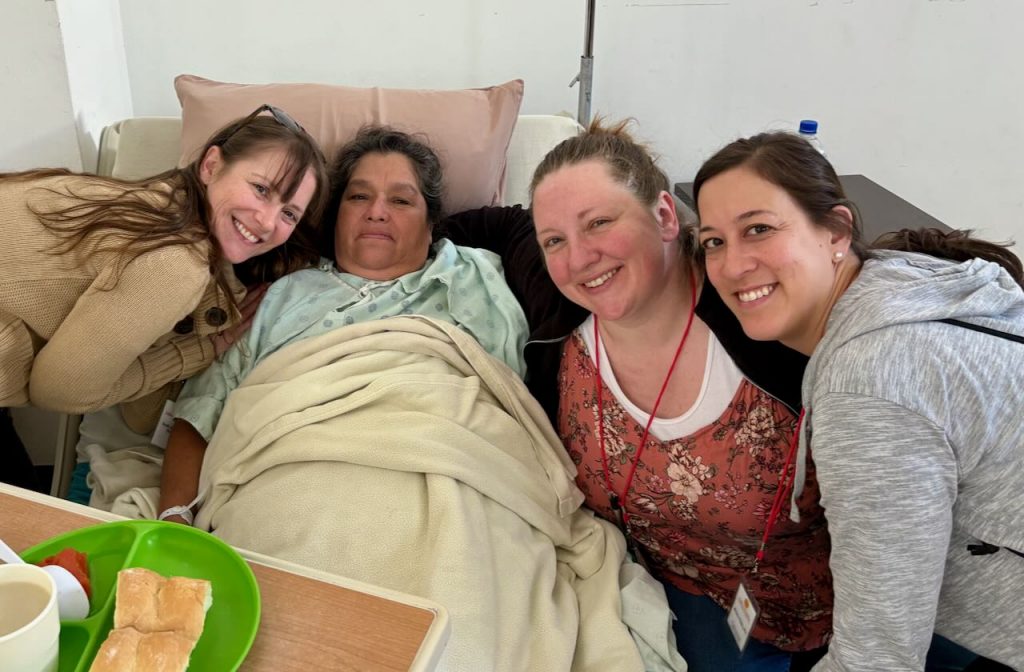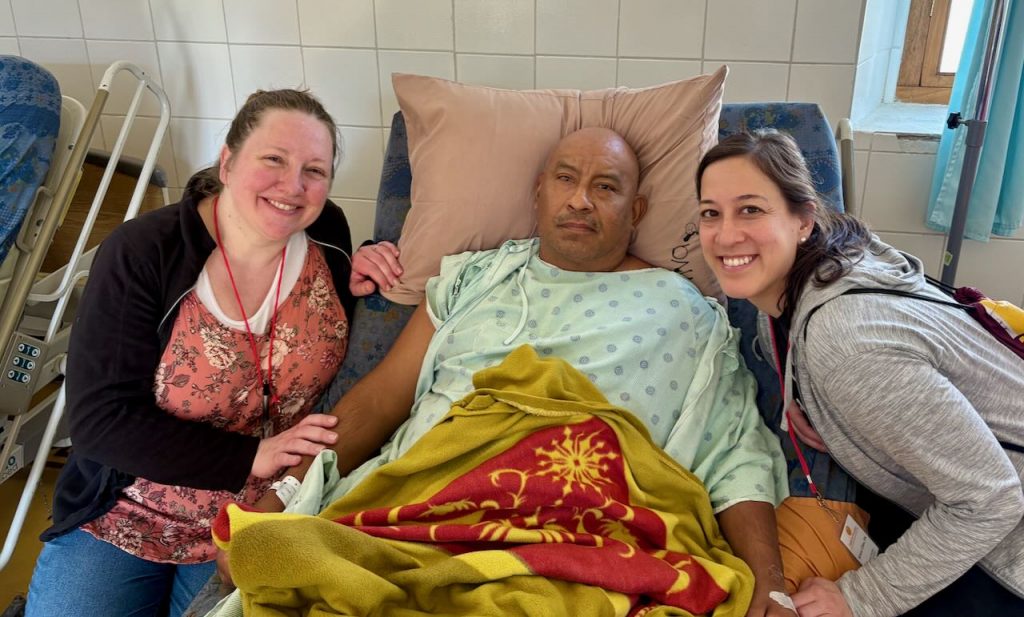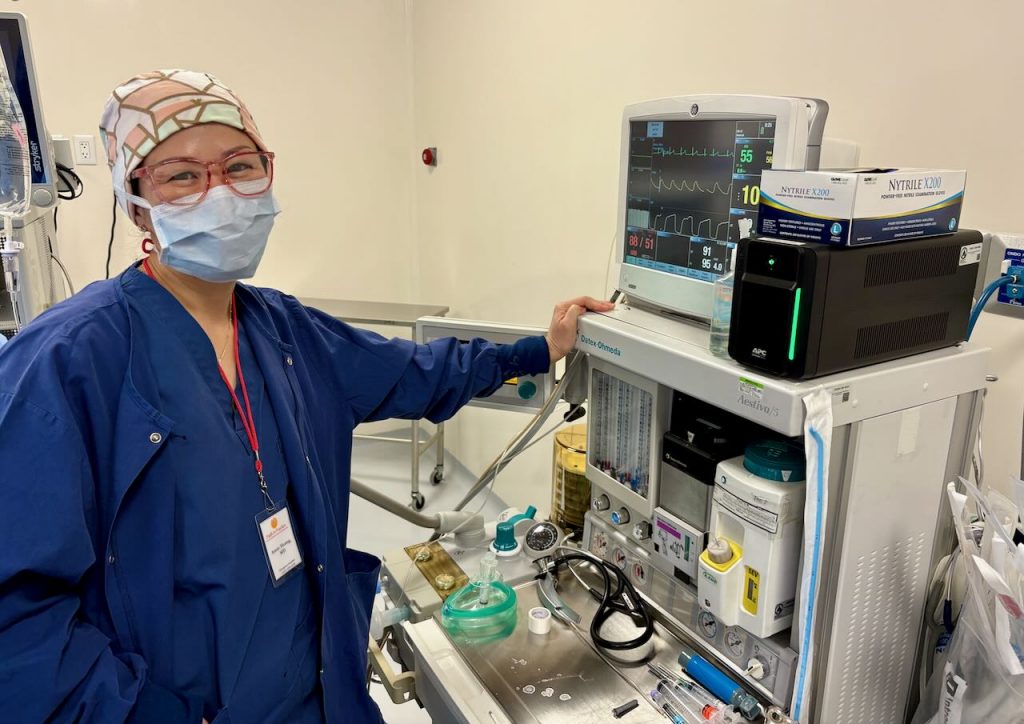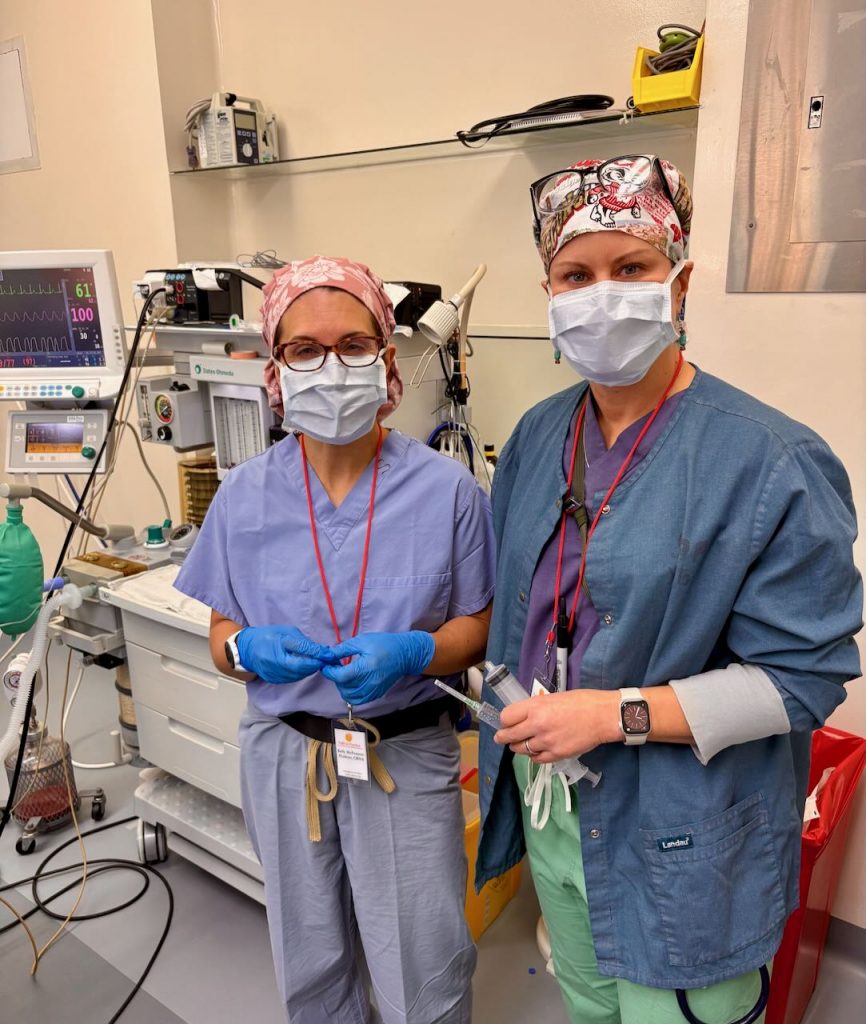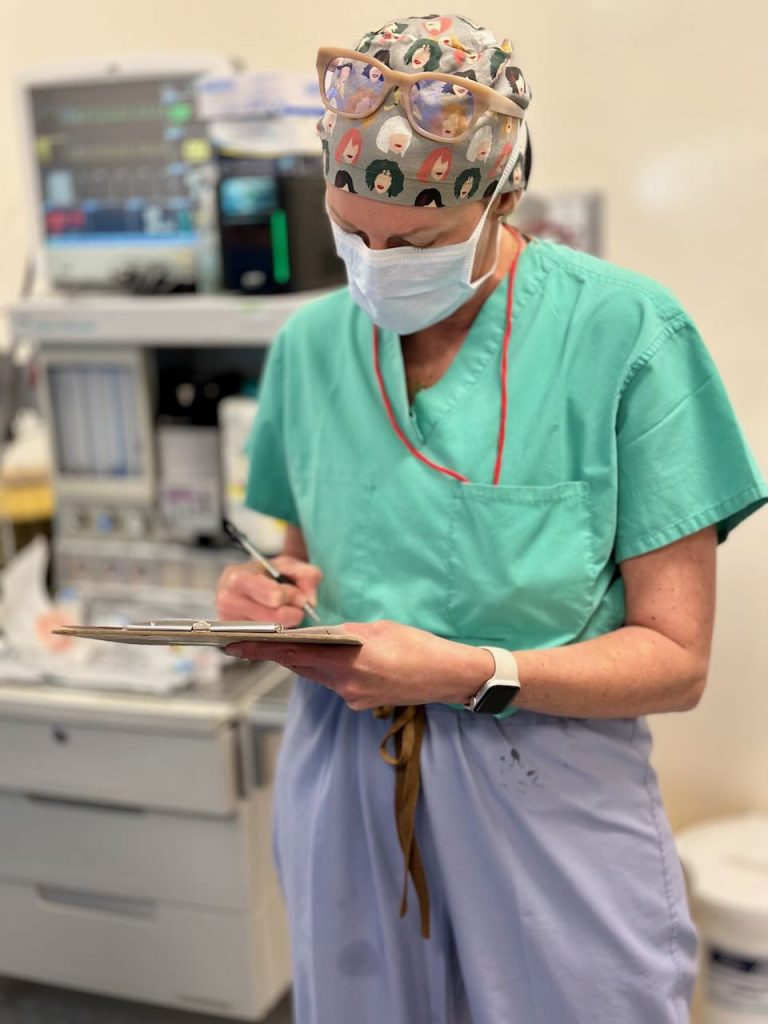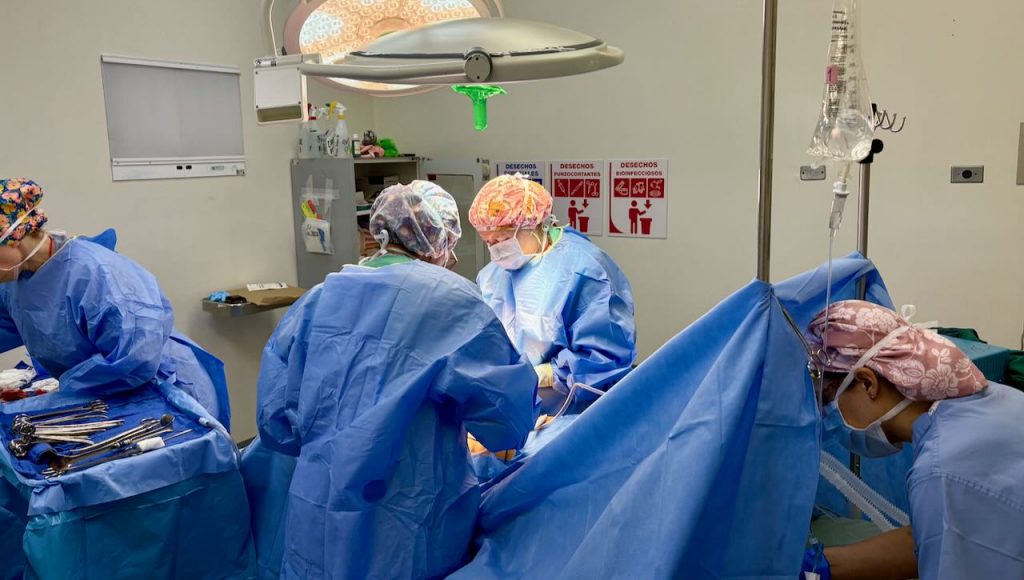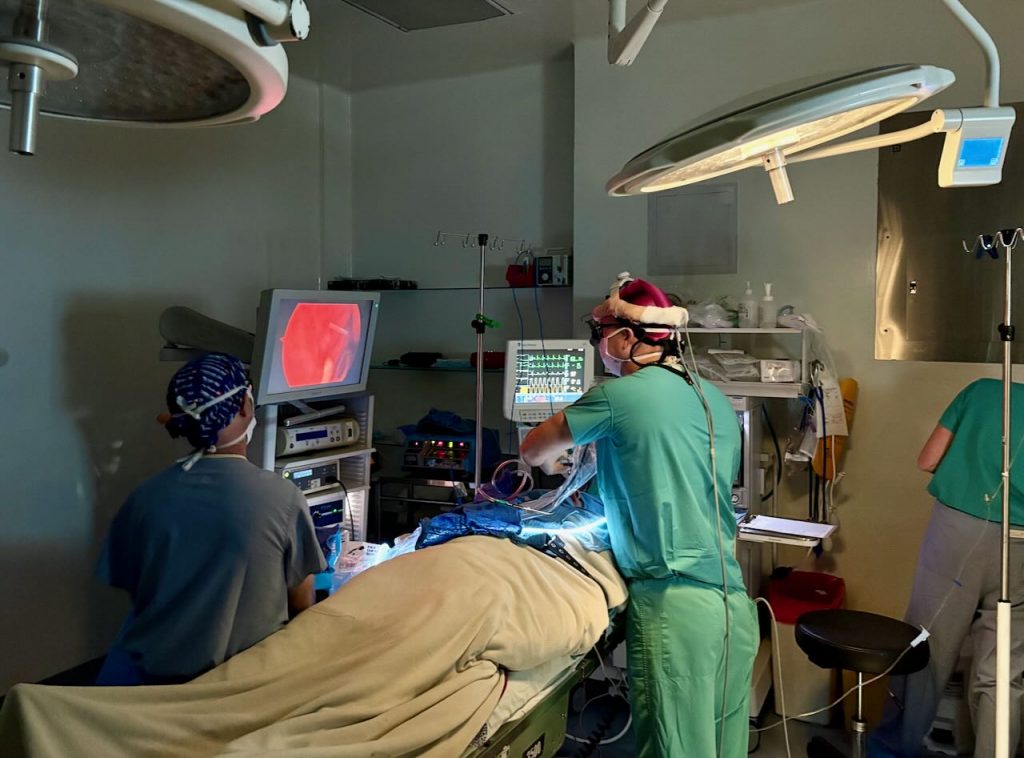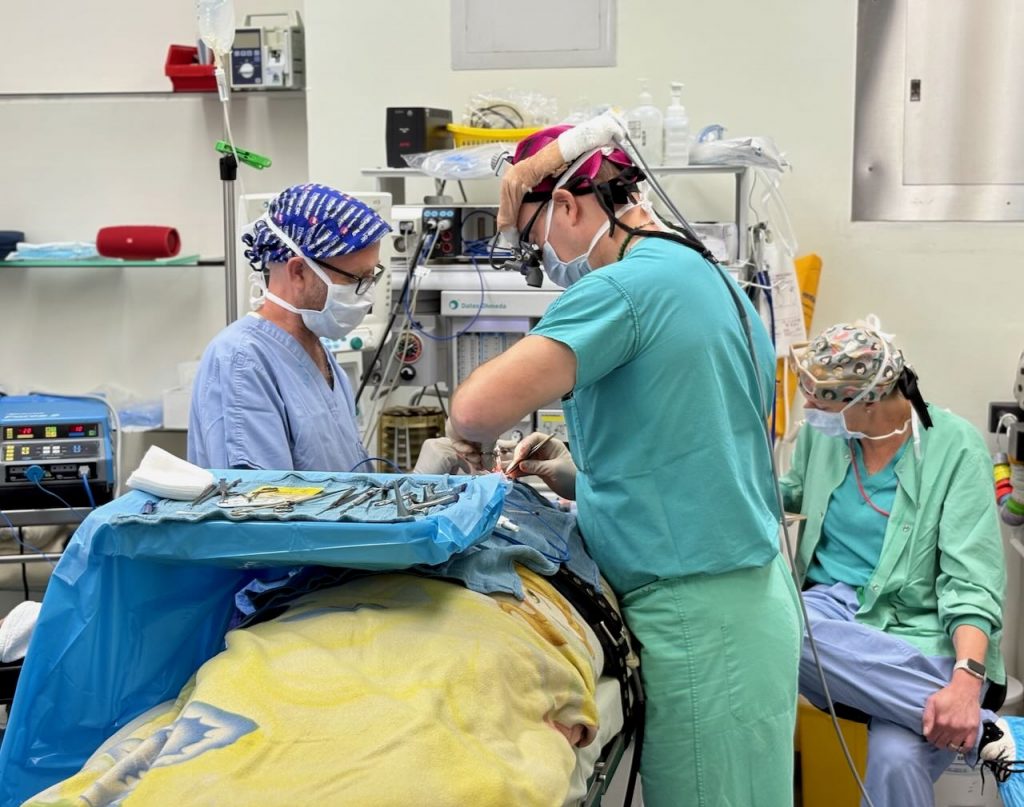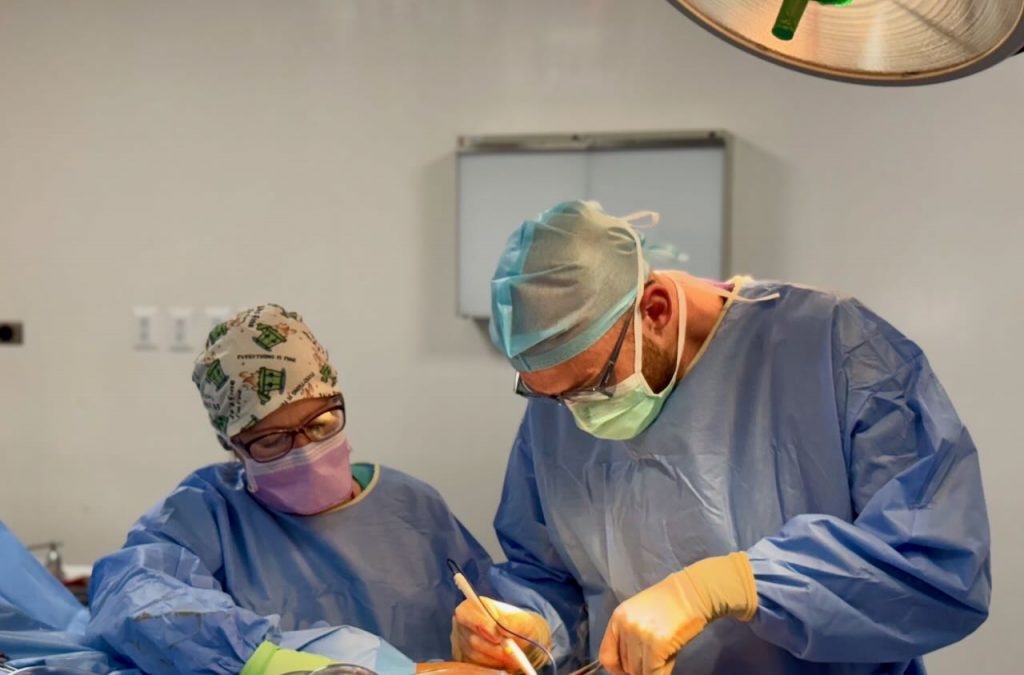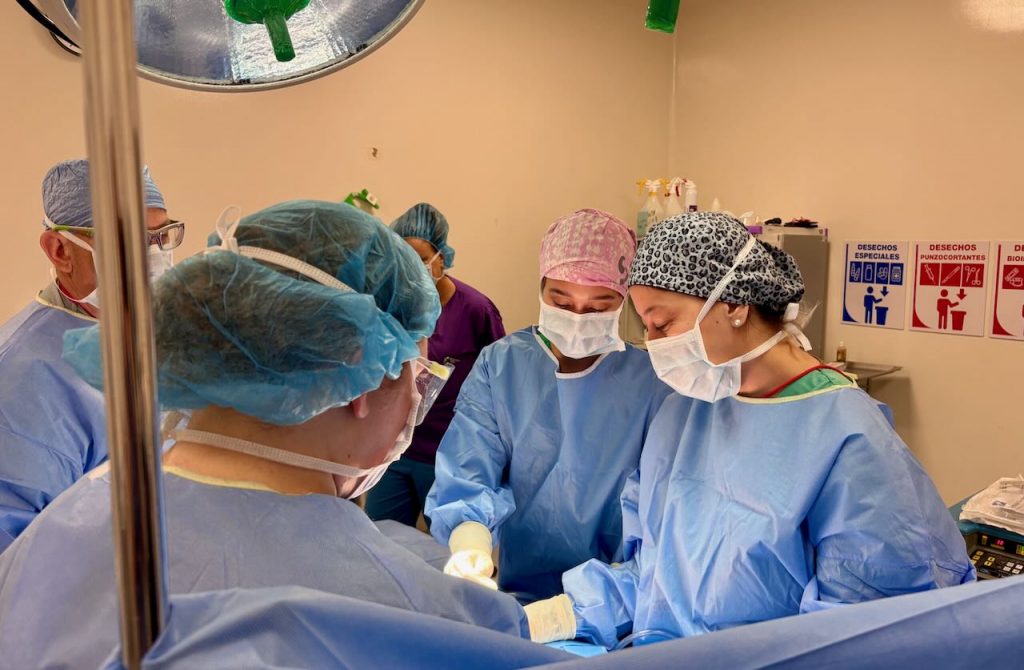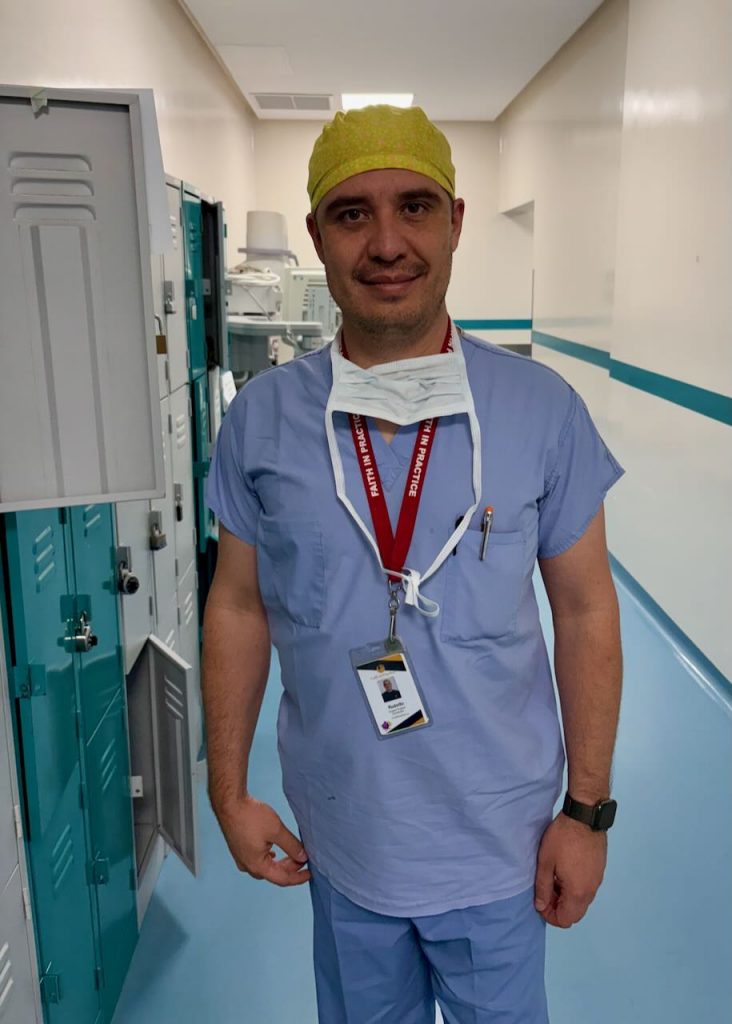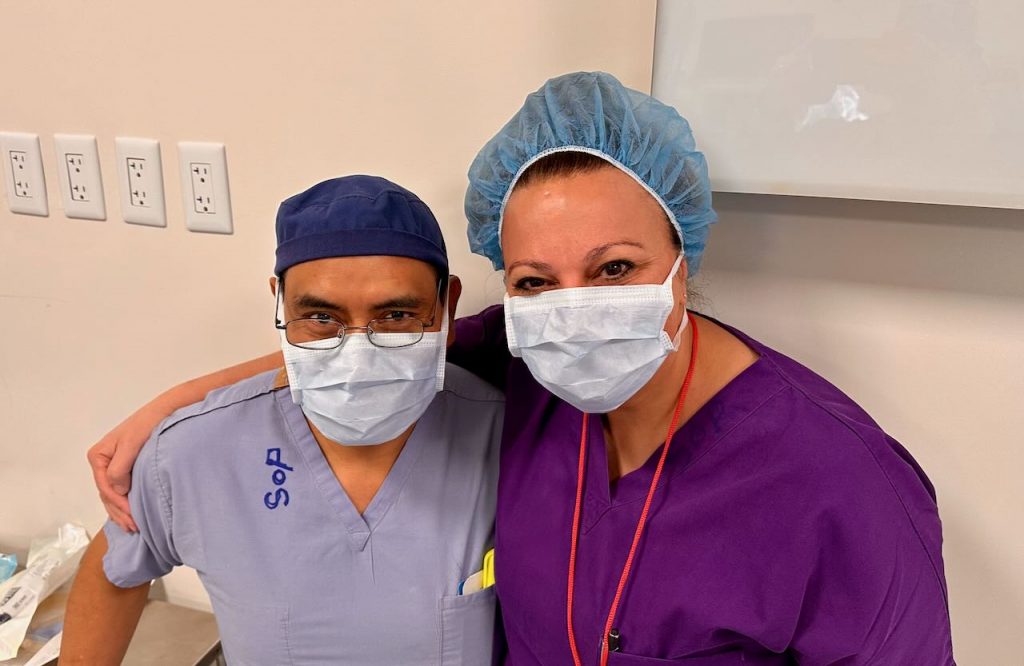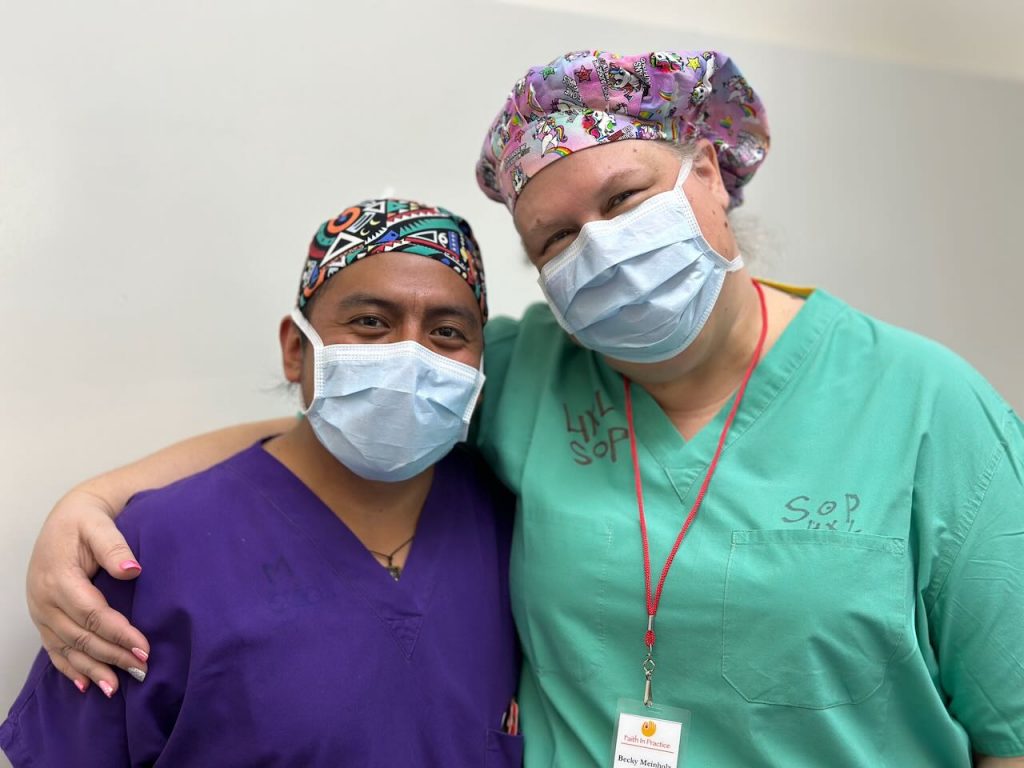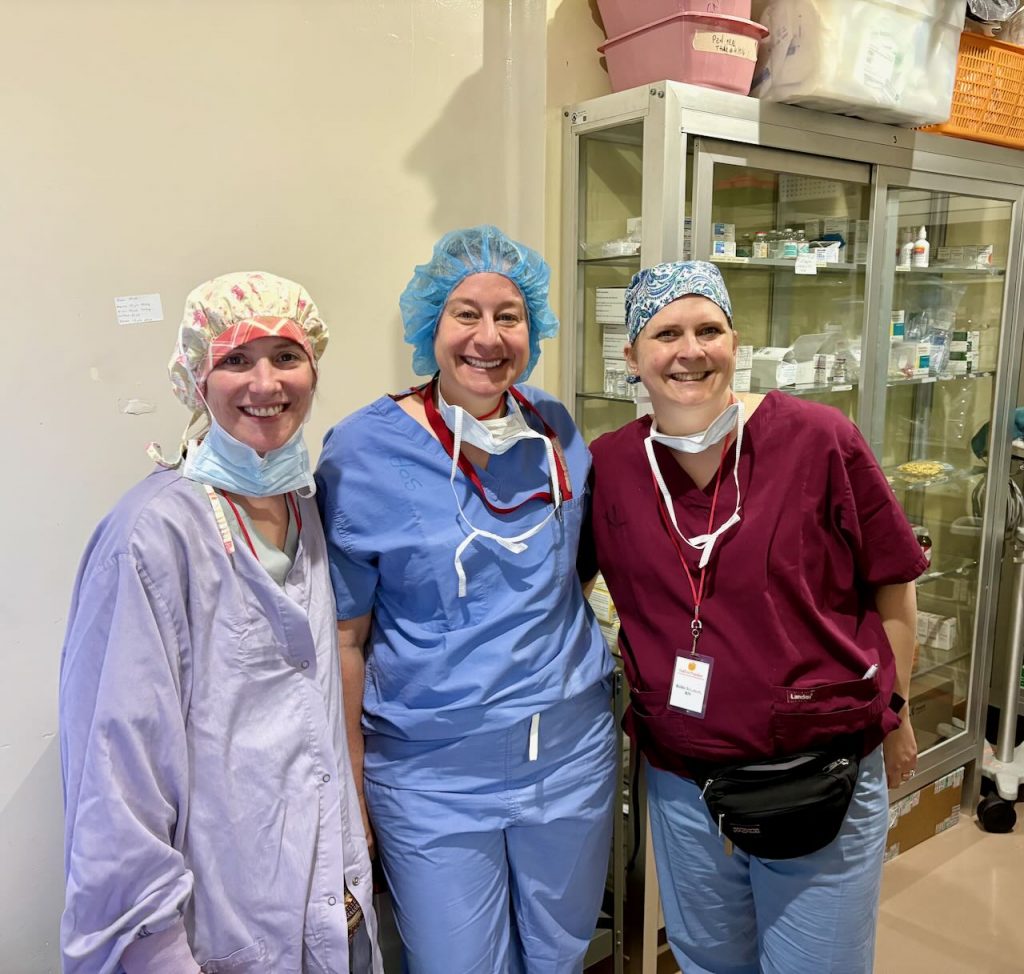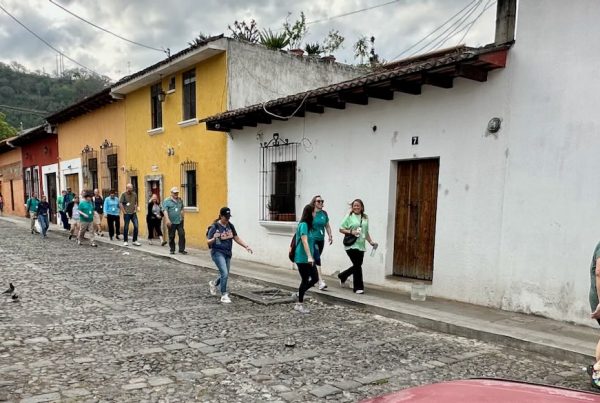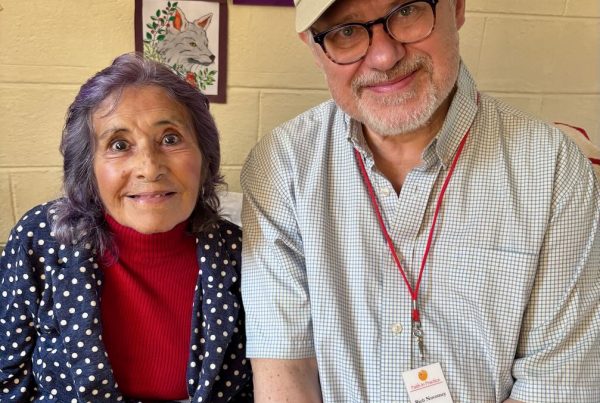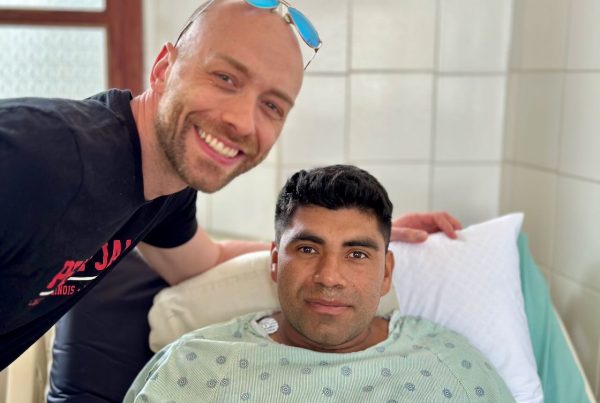Day 4 – Tuesday, 13 May
MORNING DEVOTIONAL:
Tuesday morning started with no volcanic interruptions. However, during the night we heard rumbles and what sounded like thunder. No, they weren’t digestive…it was Fuego grumbling 10 miles away.
After breakfast and lots of coffee, Beata led a brief meditation. Then Dennis talked to us about gratitude. Perhaps he chose that topic because he was grateful for no lava flows? No, all kidding aside, Dennis reminded us how grateful the Guatemalans are for our help and then wanted to explore what is the nature of gratitude. Is is a passing feeling, or a mindset? A lot to think about.
Afterwards we walked our .6 miles to the hospital.
POST SURGERY RECOVERY FOLLOW UP:
We start our Tuesday report with a follow up from Monday.
(Please see the photo above of the mother holding her child.)
Yesterday Jeff took this lovely photo of a mother comforting her child in the Post Anesthesia Care Unit. The boy, Mattias, had a tonsillectomy and had his adenoids removed. After coming out of anesthesia, he was in a lot of distress: afraid, disorientated and, most importantly, he was missing the most important person in his world. Nurses Kim and Sherry did everything to comfort Mattias. Meanwhile, our Guatemalan staff went in search of his mother (this hospital is like a labyrinth and there are many corridors, waiting areas, sections and stations). When they finally found Mattias’ mother, she was able to bring him the comfort he needed.
For me, this photo encompasses the entirety of what FIP is trying to do.
I’m posting this photo TODAY because yesterday I couldn’t confirm we’d received permission to use it. This morning Mattias’ mother gladly granted permission. Which brings us to today’s first major topic, morning rounds…
MORNING ROUNDS:
I was invited to follow a couple of the surgeons on their morning rounds. For those who don’t know, “rounds” are when physicians check up on recovering patients who are still in the hospital.
As mentioned above, we visited little MATTIAS and his mom. He was asleep this morning and still running a low grade fever, but nothing worrisome. Dr. Pogo told Mom that Mattias could leave the hospital tomorrow.
We visited little LUCRECIA, whom you might remember from yesterday’s blog. Her recovery from her tongue surgery has progressed swimmingly, and Dr. Pogo signed her release from the hospital.
(See photo above of little Lucrecia with her mother and Dr. Pogo.)
Next up we visited MARIA. Yesterday Dr. Tabitha operated on Maria for a hernia. Maria is doing very well and was very happy to have a photo with her medical team
(See photo above of Maria in a recovery bed with, L – R, Dr. Emily, who was translating, Dr. Tabitha and Physicians Assistant Krista.)
Finally, we visited CIASMO. He’s a local farmer who had a hernia repaired. Dr. Tabitha informed him that he was going home today! This is where Dr. Emily’s excellent Spanish came in handy, as she outlined for him strict instructions—in no uncertain terms—to not overdo it until his surgery heals. Ciasmo was delighted to have his photo taken with his medical miracle workers.
(See photo above of Ciasmo in a recovery bed with Dr. Tabitha on the left, and Physicians Assistant Krista to the right.)
SURGERIES IN PROGRESS:
Today many members of the Pogo Team showed me a lot the mechanics of what goes on in modern surgery. I’ll try to convey, in my layperson’s vernacular, a smidge of what I learned.
First off, Lead ANESTHESIOLOGIST Annie showed me how her equipment works. To me, it looked little different than what Dr. McCoy used on Star Trek. Things an anesthesiologist takes into consideration are age, weight, gender and medical condition. These determine what goes into the machine and how much. During any operation, the anesthesiologist or CRNA monitors this machine for the patient’s running vitals to make certain the patient is doing okay.
(See photo above of Anesthesiologist Annie with her equipment.)
Determining the dosage of AFTER SURGERY MEDICATION (typically painkillers) needs to dovetail with the patient’s anesthesiology. I found Nurse Anne doublechecking with CRNA (Certified Registered Nurse Anesthetist) Kelly where a procedure was nearing its end. This was an excellent example of how the many specialists on our teams must work closely together. No one here can function in a silo.
(See photo above of CRNA Kelly and Nurse Anne.)
Excruciatingly exhaustive RECORD KEEPING is an ongoing affair! Anywhere Team Pogo is working—triage, pre-op, post-op, OR, pharmacy, rounding, even during lunch—folks are documenting everything.
(See photo above of CRNA Katie P. writing on a clipboard…actively focused despite being peppered with questions by an unnamed photographer.)
Now to some of the surgeries conducted today:
Yesterday, the OBGYN team performed four major surgeries, and today they were back at it. Not only are these gynecological surgeries technical and exacting, they’re physically exhausting for the doctors and nurses. (Please see the photo above of Dr. Kris and Dr. Mary performing an abdominal hysterectomy. Technician Carre is to the left, CRNA Kelly is to the right.)
In some cases it’s better for a surgeon to utilize ENDOSCOPIC TECHNOLOGY to perform surgery. Today Dr. Pogo performed endoscopic nasal surgery using a narrow tube with a light and a camera at its tip. He followed his progress on the display screen in front of him.
(See photo above of the darkened OR with the illuminated red screen.)
In a FOLLOW UP to yesterday’s story of the young girl with a nose blockage, today Dr. Pogo performed her surgery. Tomorrow I’ll circle around with everyone on her progress. Because of her situation, I’m unable to even use first names.
(See photo above of Technician Paul, Dr. Pogo and CRNA Katie in the OR.)
There’s one more specialty I haven’t highlighted yet. We’ve talked about Ear, Nose and Throat with Dr. Pogo, General Surgery with Dr. Tabitha and gynecology with Doctors Kim and Mary. But we also have Dr. Jay with ORTHOPEDICS. Today when I visited, he was rebuilding a patient’s knee.
(See photo above of Dr. Jay and Technician Ellie.)
AMERICAN & GUATEMALAN PROFESSIONALS WORKING TOGETHER:
During one of Dr. Tabitha’s operations today, local Guatemalan medical student ANDREA was invited to assist.
(Please see the OR photo above with five professionals. L – R: Technician Tedd, Dr. Tabitha, Nurse Jen (barely visible), medical student Andrea and Physicians Assistant Krista.)
ANDREA and I spoke afterwards. Andrew grew up in Guatemala City and has been in Medical School for 5 years and has 3 more to go. When I asked her why she decided to pursue this long and difficult path to become a physician, she told me her grandmother inspired her. As she was growing up, Andrea said her grandmother was “so weak,” she wished there had been something she could’ve done for her. Years later, Andrea is now learning the skills to expertly help others. She also told me she was very grateful to work with these American doctors so she could learn other perspectives and techniques.
And what did I learn from talking to Andrea? That our medical mission is not only about healing, it’s about TEACHING.
Next up, I’d love to talk about our local Faith in Practice Surgical Coordinator, RODOLFO.
(Please see the photo above of Rodolfo in the hallway next to the lockers).
Rodolfo has been working for FIP for 10 years and grew up locally. Rodolfo is way too modest; he downplays his skills, and yet for the past 3 days, I’ve seen Rodolfo everywhere, helping everyone—from snooping out missing equipment to troubleshooting the medical software. For a while I was convinced Rodolfo had a twin. Also, I’m partial to Rodolfo because he’s the one who finally scrounged up a locker key for me!
Please see the next two photos above for two other examples of how the American team dovetails so beautifully with the Guatemalan team: L – R, Nurse Benito with Nurse Jen (you can’t miss Jen, she’s in bright purple scrubs), and L – R, Nurse Samuel with Nurse Becky.
PHARMACY FOLLOW UP:
You might recall yesterday I could never catch a shot of our Pharmacist Katie. Today I got her photo…along with a bonus. I found Katie with Dr. Emily and our CHARGE NURSE Kellie. Kellie is even more difficult to corner than Katie. Kellie is essentially running the whole show and dashes between all the different stations and ORs on an ongoing basis, making sure that each scheduled patient is where they should be, and that everyone is ready for them.
(Please see photo above of three women, L – R: Dr. Emily, Pharmacist Katie and Charge Nurse Kellie.)
A SHOUT OUT:
Allow me to pause a moment to give a shout out to two of the people who’ve helped me most while I’ve scampered about here in Antiqua: BEATA and DENNIS.
Beata is our “Den Mother,” and wears many hats. She leads yoga very early in the mornings, leads our after breakfast meditations, provides translations for patients, and helps the nurses in the Post Anesthesia Care Unit. Plus I’m confident she’s doing things I don’t ever see. She’s helped guide me these first few days with many of my “silly questions.” She’s partners with Dr. Pogo, and with him Beata has been on many medical missions. She knows the ropes and dispenses advice and grace with wisdom and common sense.
Dennis is our Chaplain. But he is sort of un-chaplain like, and I mean that as a compliment. He doesn’t have a judgmental bone in his body, and approaches all of the team members on their own terms. He leads our morning devotionals, but I wouldn’t call them devotionals, rather thought-provoking discussions. He opens each morning with an insightful observation which then leads to a brief discussion. This helps start the day with the entire team on the same page. He’s always positive and often suggest new ways of looking at almost everything. And he’s wicked smart…probably smarter than the team blogger.
(See photo above of Beata and Dennis in scrubs and smiles.)
RELATED NOTES AND THOUGHTS: WHAT MAYAN CIVILIZATION LEFT US
The Classic Mayan era extended for around 500 years, from about 250 AD to 950 AD. From a Europe-centric perspective, it might be easy to forget some of the amazing things they discovered and accomplished, well ahead of their counterparts across the Atlantic:
ASTRONOMY: Their understanding of how our planets moved helped the Mayans develop a calendar that was much more accurate than the Julian calendar used in Europe at the same time.
UNDERGROUND RESERVOIRS AND WATER PURIFICATION OR FILTRATION: The Mayans created reservoirs beneath many of their great buildings. And used zeolite, a naturally occurring volcanic compound, to help filtrate their reservoirs. It’s ironic that today, fresh water is a major challenge in rural Guatemala.
INVENTION OF RUBBER AND ELASTICS: They invented latex and used them for the balls in their ritualistic Mayan Ball Games.
CHOCOLATE: It’s that thing we all love! The Mayans invented it. They considered chocolate “the food of the gods.”
MEDICINE: We northerners have traveled down here to share our medical expertise with the local Mayans, but it’d be good to remember that while Europe was mired in the Dark Ages, Mayans were using hair and needles to stitch up wounds, knew how to set broken bones and practiced dental repair with iron pyrite as fillings for cavities, and created dental implants.
Indeed, like the Mayan Calendar, sometimes things do seem to move in circles.
CORRECTIONS: Please pardon my errors from the previous days’ blogs: I misspelled Beata’s and Sherry’s names.
–Rich, Pogo Team Blogger
Photos for this entire week are by Jeff E. and Rich N.


